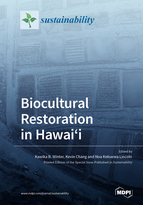Biocultural Restoration in Hawaiʻi
A special issue of Sustainability (ISSN 2071-1050). This special issue belongs to the section "Environmental Sustainability and Applications".
Deadline for manuscript submissions: closed (31 July 2018) | Viewed by 119527
Special Issue Editors
Interests: social-ecological system theory; biocultural conservation
Interests: environmental law and policy; social movement networks
Special Issue Information
Dear Colleagues,
Hawaiʻi has been a regional leader in biocultural restoration as it is home to many projects which aim at restoring the health and function of systems that exist in the confluence of nature and humanity. In this endeavor, there have been multifaceted approaches to facilitating the return to a state of perpetual resource abundance, known in the Hawaiian language as ʻāina momona. Several of the more successful attempts in this movement have merged both ancestral and contemporary science, technology, and philosophy to inform adaptive practices in multiple fields as a means to build projects, programs, and initiatives.
In this Special Issue, we will highlight viable models in the larger effort to restore ʻāina momona, with some focus on the management of forest, streams, nearshore fisheries, traditional crop diversity, traditional food systems, and health and wellness; as well as the legal and policy steps needed to build a foundation that can facilitate this change. We want to emphasize the biocultural foundation in social-ecological system theory; and the manners in which restoration of biocultural diversity, along with the health/function of social-ecological systems, can be founded in cultural values and aligned with community priorities. Manuscripts focusing on biocultural restoration in Hawaiʻi will be accepted for consideration.
Purpose and strategic opportunity:
- Highlight the cutting-edge work that is happening in Hawaiʻi
- Provide references for biocultural restoration policy and research in Hawaiʻi and the Pacific Region
- Collectively raise the conversation regarding mālama ʻāina in Hawaiʻi
- Raise up some of Hawaiʻi’s “thought leaders” on this front (via publishing and editing)
○ Tenure track professors
○ Mālama ʻĀina professionals
○ Network hubs
- Give voice to elders and those who follow in their footsteps
- Connect research to on the ground community relevance
Dr. Kawika B. Winter
Dr. Kevin Chang
Prof. Dr. Noa Kekuewa Lincoln
Guest Editors
Manuscript Submission Information
Manuscripts should be submitted online at www.mdpi.com by registering and logging in to this website. Once you are registered, click here to go to the submission form. Manuscripts can be submitted until the deadline. All submissions that pass pre-check are peer-reviewed. Accepted papers will be published continuously in the journal (as soon as accepted) and will be listed together on the special issue website. Research articles, review articles as well as short communications are invited. For planned papers, a title and short abstract (about 100 words) can be sent to the Editorial Office for announcement on this website.
Submitted manuscripts should not have been published previously, nor be under consideration for publication elsewhere (except conference proceedings papers). All manuscripts are thoroughly refereed through a single-blind peer-review process. A guide for authors and other relevant information for submission of manuscripts is available on the Instructions for Authors page. Sustainability is an international peer-reviewed open access semimonthly journal published by MDPI.
Please visit the Instructions for Authors page before submitting a manuscript. The Article Processing Charge (APC) for publication in this open access journal is 2400 CHF (Swiss Francs). Submitted papers should be well formatted and use good English. Authors may use MDPI's English editing service prior to publication or during author revisions.
Keywords
- co-management
- tradition ecological knowledge
- traditional resource management
- social-ecological system







